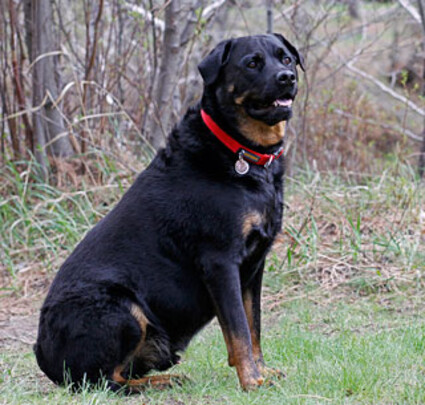Beware of mule deer aggression
Last updated 6/10/2014 at Noon
Last week Otis, a male rottweiler, was attacked by a mule deer doe inside Sisters city limits. Sisters resident Tracy Foteff had him harnessed on a leash and was walking him down an access trail to Whychus Creek in the Timber Creek subdivision near Sisters Elementary School.
"We were walking to the creek when all of a sudden a doe stood up behind a bush that we were walking by," she said. "I didn't think anything since Otis is a large dog; we kept on going, but suddenly she charged at us. She jumped on Otis, kicking his side over and over. He seemed to be in shock because he didn't bark or growl. I yelled and tried to pull him away, but it didn't do any good, until I grabbed a hand of gravel and threw it at the doe. Then she backed off. We were both very shaken by what happened. I took Otis to the veterinarian, and luckily he's just bruised."
This incident is a reminder to residents that urban deer can be dangerous.
Does are of particular concern during the spring fawning season (May and June). They have a very strong instinct to aggressively defend their fawns when people, especially those walking their dogs, come anywhere near. If deer are responding to your presence, then you are too close. Always keep your distance (at least 50 feet). The safest way is to walk away from the deer slowly. Keep your dogs on a leash at all times.
There is a substantial deer population in Sisters Country and that includes inside the city limits and inside rural subdivisions. The urban area provides a relatively safe haven from predators and is an attractive source of food for deer.
When deer become habituated to the presence of humans, they lose their natural wariness of humans. Although deer may look cute and harmless, they can become very aggressive to people and dogs, according to Oregon Department of Fish and Wildlife (ODFW).
"People need to be aware that any wildlife with young can cause a problem. These deer are survivalists and are used to being attacked by coyotes. Providing food for deer is the root cause of an increase in wildlife/human/dog conflict. Never approach or feed a deer," said Randy Lewis, regional wildlife volunteer program coordinator for ODFW.
Deer have also jumped low fences to get into residents' yards seeking food such as flowering plants and shrubs. If you have a dog that stays in the yard, keep a close watch on him. Deer have attacked small dogs while in a yard searching for food.
Landscaping with deer-resistant plants and high fencing can help keep deer out of your yard.
Play it safe, and do not entice or feed the deer. Walk in the other direction when you spot a deer, even if you don't see any fawns. The doe will hide her fawns deep in the woods and go searching for food, and if anyone comes too close, she will aggressively defend her territory.

















Reader Comments(0)